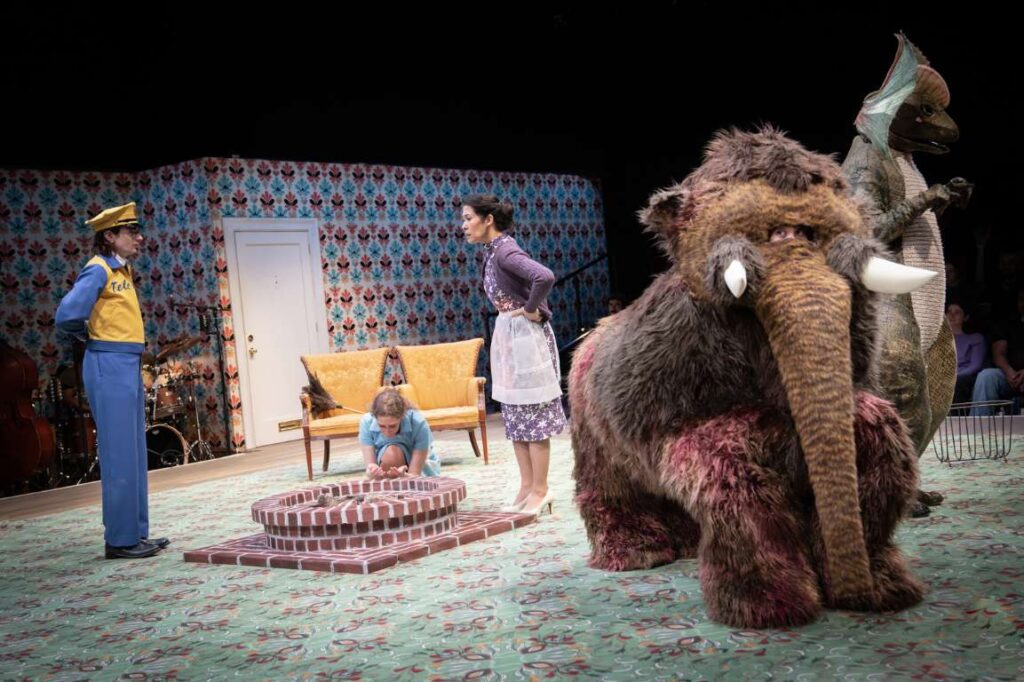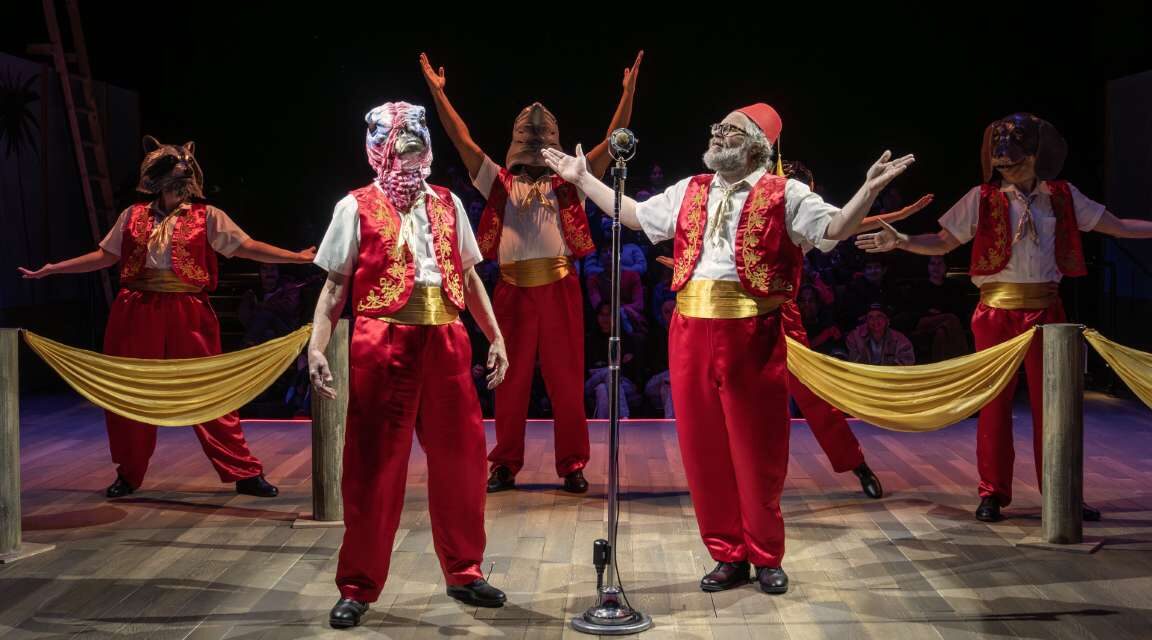Review by Carol Rocamora…
Wilder gets wilder in this update of his classic at the Public Theater
Wait till you meet the Antrobuses… They’re a nice, middle-class American family, living with their kids Henry and Gladys in Excelsior, New Jersey. George is an inventor and Maggie is a diligent mother and housewife. Oh, yes, one more detail: they’ve been alive for 5,000 years (and no, that’s not a typo). So if you think that we are living through traumatic, tumultuous times today, you can only imagine what they have lived through…
Actually, you don’t have to imagine it. Ethan Lipton (adapter, composer, lyricist) does it for you in his new musical entitled The Seat of Our Pants, now playing at the Public Theatre in a large-scale production directed by Leigh Silverman. Yes, that’s right, all 5,000 years condensed into two-and-a-half hours.

If this already sounds familiar, memory serves you well. Lipton’s new work (ten years in the making) is a faithful adaptation of Thorton Wilder’s The Skin of Our Teeth, the award-winning epic written in 1942 at a time of enormous crisis. It was wildly ambitious then; it feels even more so now, and oh so challenging to follow.
Take Act One, for example. The setting is the Antrobus home in New Jersey. The family’s household maid Sabina (a ubiquitous Micaela Diamond) tells us that “we made it through the recession-pandemic wildfire oligarchy by the seat of our pants.” With that remark, we assume the setting is contemporary. So then why are there remarks about George’s brand-new inventions of the wheel and the alphabet? Why is there a reference to a child that the Antrobuses lost, named “Abel”? (Henry is referred to as “Cain”). Why are the household pets a dinosaur and a mammoth? Why is it freezing in August? Because a messenger is forecasting an ice age that’s about to descend upon them. This announcement is followed by the entry of a throng of desperate people to whom the Antrobuses are offering shelter.

OK, now we get it – it’s an allegory of the history of mankind, set in numerous times simultaneously. Yes, it’s amusing, but hard to follow, with so many different time frames overlapping one another. It’s also hard to know whether to laugh or to be alarmed. After all, the show’s opening musical number is “The World Is Ending,” led by a cheerful Announcer (Andy Grotelueschen) who continues to narrate throughout the play.
But his narration doesn’t help in sorting out time and place. Act II gets more incomprehensible. It takes place in Atlantic City (not sure why or when) at a convention, where the “Miss Atlantic City” contest is taking place. George (played by Shuler Hensley) appears to be having an affair with the contest winner (also played by Micaela Diamond). Enter a fortuneteller (Ally Bonino), announcing an oncoming storm (with references to Noah’s Ark).
In Act III, we’re back in Excelsior, New Jersey, where Henry (Damon Daunno) has returned from a seven-year war during which he killed “a lot of people.” Gladys, meanwhile, has had a baby (whose, we’re not sure). There are reports of widespread devastation and starvation. “I’ve lost the desire to begin again,” George laments.
To make matters even more distracting, adapter Lipton has enhanced the metatheatrical device that Thorton Wilder used in his original – namely, of characters who constantly interrupt the action and talk directly to the audience. It begins in Act I, for example, when Sabina breaks character during the crowd entrance, and says to the audience: “Oh, I see what this show is about…refugees!” Then she adds: “Will you save the human race?”, asking us to give up our seats for the incoming crowd. These metatheatrical interruptions, at first amusing, are frequent to the point of being irritating. “Maybe I should keep going for a second Tony, or an Obie?” an actor in Act III asks the audience.
What keeps this jumbled musical alive is its high entertainment value. Set designer Lee Jellinek has restructured the Newman Theatre into a corridor configuration, with audience members facing each other. On either side, an excellent ten-member musical ensemble plays Lipton’s lively songs (under Nathan Koci’s direction). Leigh Silverman superbly directs a spirited nineteen-member ensemble featuring Ruthie Anne Miles as Maggie Antrobus, the play’s moral force, and the ever-ready Micaela Diamond in two high-profile roles. Damon Daunno is a rebellious Henry, and Gladys is a touching Amina Faye. Sunny Min-Sook Hitt choregraphs numerous dance numbers featuring this impressive ensemble in Kay Voyce’s colorful costumes.
Ultimately, the message, never subtle, is repeated throughout this ambitious adaptation. “We’re a Disaster!” sings the ensemble in the final act. But mankind keeps getting a second chance. “We start anew,” goes the final chorus. “It’s what we do.”
I suppose that’s a reassuring message, if you can believe it in our troubled times.
In his enlightening program notes, Oskar Eustis, the Public Theatre artistic director, acknowledges that “rarely has a play so acclaimed had a tone and style so hard to follow.” That is essentially the problem with this allegorical play that no adaptation – however well-intended – can overcome. Still, Lipton and his artistic ensemble are to be commended for their passionate, entertaining, thought-provoking effort.
“This will be a meaningful show,” Sabina tells us. Yes, we get it.
The Seat of Our Pants, adaptation/music/lyrics by Ethan Lipton, based upon Thornton Wilder’s The Skin of our Teeth, directed by Leigh Silverman, now through December 7.
Photos: Joan Marcus


